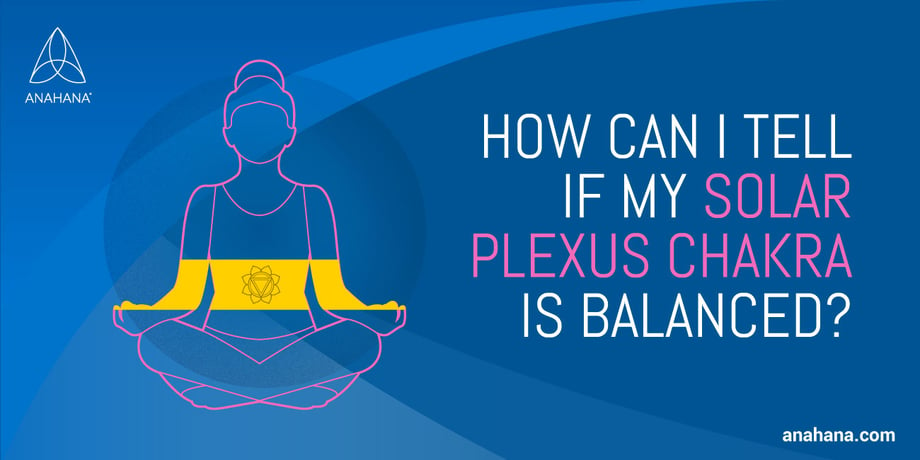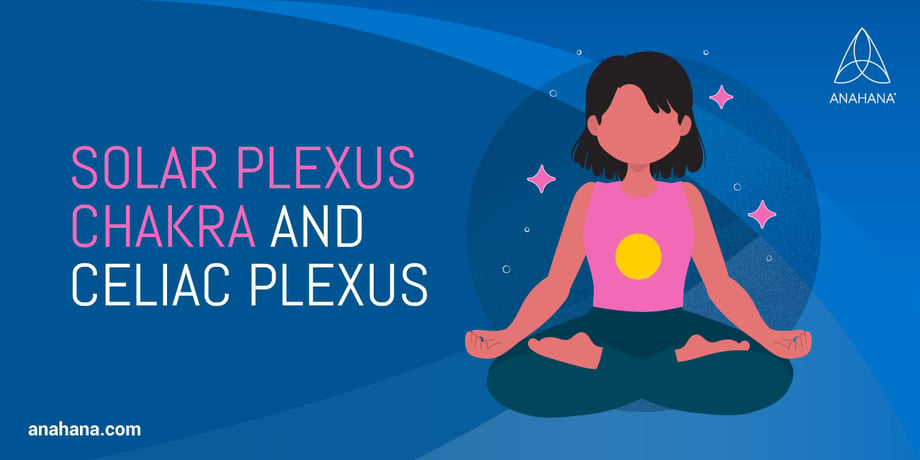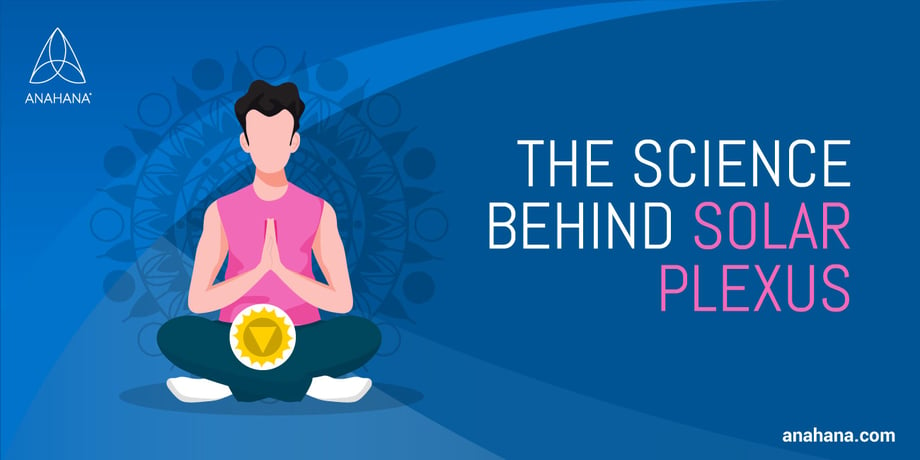
Table of Contents
The Solar Plexus is both a biological component of the body and a spiritual chakra. Understanding it means having a deeper understanding of energy, mood, digestion, and physical/mental power.
Key Takeaways
- Definition: The solar plexus, or celiac plexus, is a network of sympathetic nerves in the abdomen, associated with the third chakra in spiritual beliefs.
- Location: Found in the upper abdomen, between the ribs and belly button.
- Functions: Manages abdominal pain, some digestive functions, and overall pain management in the physical body.
- Disorders: You may experience solar plexus pain, or severe pain, along with digestive issues, mood changes, anxiety, and depression.
- Healing: Yoga, meditation, and sunlight exposure can help balance the solar plexus chakra.
The solar plexus
Ancient Indian yogic beliefs describe chakras as energy centers in the body. The third chakra, the Solar Plexus, also known as the yellow chakra, represents warrior energy. When it is unbalanced, it results in a loss of personal power and poor digestive health.
The solar plexus also refers to a bundle of nerves in the abdomen that functions in digestion and mood. Since there is no direct scientific research on chakras, consideration of the third chakra in human biology requires a dual approach.
The spiritual and physiological concepts exist independently, but they share many parallels.
What is the Solar Plexus chakra?
The chakra system describes energy centers in the human body according to ancient Indian yogic beliefs. In Sanskrit, chakra translates to “spinning wheel.” These energy centers are distributed throughout the body, but seven main chakras lie along the spine. From the tailbone to the top of the head are the Root chakra, Sacral chakra, Solar Plexus chakra, Heart chakra, Throat chakra, Third Eye chakra, and Crown chakra.
The third chakra, the Solar Plexus, falls in the middle of the belly below the ribcage. Its Sanskrit name is Manipura chakra, which translates to “lustrous gem.” It is a fitting name because the Manipura chakra is associated with the chakra color yellow, inner fire, and the sun. This chakra governs personal power and warrior energy.
How can I tell if my Solar Plexus chakra is balanced?

The Solar Plexus chakra is responsible for confidence, personal power, and the sense of self. When this chakra is balanced, feelings of security and capabilities fill the entire body. The ability to take risks and make decisions with confidence will increase. It will be easier to practice self-compassion and self-assertion. Improvements in digestion and increased energy levels will be noticed.
A blocked Solar Plexus chakra may cause insecurity, self-doubt, and negative thought patterns.
Stomach pain or digestive issues are additional signs of Solar Plexus chakra imbalance.
What is the Solar Plexus in the Body?
The third chakra gets its name from its location in the solar plexus area of the body. It falls within the upper abdomen region, between the ribs and the belly button.
The solar plexus comprises a network of nerves that sits just below the diaphragm, right in front of the first lumbar vertebra. The solar nerve plexus earned its name from the many nerve fibers that radiate from it, like sun rays.
Scientific works often refer to the solar plexus by its other name, the celiac plexus. For clarity, this article will use ‘Celiac Plexus’ or ‘CP’ in biological contexts and ‘Solar Plexus’ when discussing the chakra.
What are the functions of the celiac plexus?

The CP coordinates nerve signals for abdominal pain and some digestive functions. The incoming nerve fibers primarily derive from the splanchnic and vagus nerves. The splanchnic nerves are part of the sympathetic nervous system (fight-or-flight), while the vagus nerve is part of the parasympathetic nervous system (rest-and-digest).
The vagus nerve picks up sensory input from many digestive organs and carries some of these signals through the CP. Examples include stomach fullness and blood glucose levels.
The CP also transmits signals for abdominal pain. In disorders like pancreatic cancer and chronic pancreatitis, abdominal pain can be so severe that doctors may perform a celiac plexus block to stop the pain signals from transmitting through the CP.
Outgoing signals from the CP are primarily sympathetic and travel via the splanchnic nerves.
CP output acts on most digestive organs and functions primarily to inhibit digestion and increase blood glucose.
This output frees up energy for the body’s fight-or-flight response to stress or danger. Some key functions are:
- Stomach and intestines: Decrease movement through the digestive tract by constricting sphincters and inhibiting smooth muscle contractions
- Gallbladder: Inhibit the release of bile
- Pancreas: Inhibit secretion of digestive enzymes and insulin
- Liver: Increase glycogenolysis (release of stored glucose) and gluconeogenesis (formation of glucose)
The CP is associated with many digestion issues, including abdominal pain and cramping, bloating, nausea and vomiting, indigestion, acid reflux, constipation, and diarrhea.
It is also associated with fatigue, mood changes, anxiety, and depression.
Is the Solar Plexus chakra associated with the celiac plexus?
The Solar Plexus chakra and the solar nerve plexus are two distinct entities since the chakra system is spiritual, not physiological. However, some believe that the chakras may be interconnected with bodily systems.
The Solar Plexus chakra is often associated with the digestive and endocrine systems.
There is no proven connection between this nerve plexus and the Manipura chakra. Still, we can see some similarities as the solar plexus plays roles in digestion and mood in both manifestations.
How does one heal the Solar Plexus chakra?
The Solar Plexus chakra may benefit from several healthy habits. Yoga postures, such as seated spinal twist, bow pose, boat pose, and warrior pose, help open and balance the Solar Plexus chakra.
Meditation, breathing exercises, or visualization may also positively affect the chakra.
Since this chakra is associated with the sun and the yellow element, spending time outside in the sunshine may help. Practicing self-affirmation fosters a strong sense of self, and repeating positive affirmations combats negative energy.
There are a few solar plexus-balancing foods that bring positive effects. These include yellow foods and spices such as yellow bell pepper, lemon, ginger, turmeric, and saffron. Cilantro (coriander) and solar plexus balancing teas, such as chamomile or lavender, are also among the food and drinks that balance the chakra.
What is the scientific evidence for these practices?
 Chakras are spiritual beliefs, so they are not the subject of direct scientific research. However, there is extensive emerging research into related topics, such as yoga, mindfulness, and nutrition, and how they impact digestive function and mood.
Chakras are spiritual beliefs, so they are not the subject of direct scientific research. However, there is extensive emerging research into related topics, such as yoga, mindfulness, and nutrition, and how they impact digestive function and mood.
Scientific studies indicate that the suggested practices promote healthy digestion, create a positive mood, and lead to personal power changes.
The involvement of the Manipura chakra is up to personal beliefs, but the benefits are clear regardless.
Digestive function and mood are connected
People with chronic gastrointestinal disorders such as pancreatitis, gastroparesis, and irritable bowel syndrome (IBS) are at a significantly higher risk for depression and anxiety. There also appears to be a correlation between the severity of gastrointestinal symptoms and psychiatric symptoms.
The mechanism and directionality of the relationship between the gut and mood require additional research, but its existence is well-established. Blockage of the Solar Plexus chakra causes digestive issues. It also results in low self-esteem and confidence, which may occur with depression or anxiety.
Antidepressant and anti-anxiety effects of yoga
The evidence for yoga’s antidepressant and anti-anxiety effects is vast, although it varies in strength due to the wide range of studies. However, a review of numerous meta-analyses concluded that robust evidence supports yoga’s mental health benefits. These effects are particularly true for mindfulness-based yoga, as opposed to exercise-based.
Depression and anxiety can often result in fatigue, decreased self-confidence, and lack of self-compassion, which are symptoms of a blocked Solar Plexus chakra.
Yoga improves self-esteem across different age groups
Decreased self-esteem is a hallmark of a blocked Solar Plexus chakra.
Three studies examined the effects of consistent yoga practice on specific age groups: children aged 9 to 12, adolescents aged 13 to 18, and men aged 40 to 60.
In school-age children, daily hour-long yoga practice significantly increased self-esteem, attention, concentration, and memory after 4.5 months.
In teenagers, regular yoga practice correlated with significantly higher self-esteem and positive feelings (e.g., happiness, energy, focus) and significantly lower negative feelings (e.g., sadness, anxiety, lethargy).
In middle-aged men, two 75-minute yoga and mindfulness sessions per week significantly improved depression symptoms after four weeks and self-esteem and psychosocial quality of life after 12 weeks.
Yoga and mindfulness benefit digestive health
Research on the digestive health benefits of yoga and mindfulness is less extensive than the research on mental health. However, some studies have examined these benefits in digestive disorders, including constipation, chronic pancreatitis, and gastroesophageal reflux disease (GERD).
Constipation is a common digestive problem, especially with aging. A study on participants aged 60 to 75 found that three yoga sessions per week significantly decreased constipation and the associated physical and psychological discomfort after three months. They also experienced improved sleep quality.
In chronic pancreatitis patients, hour-long sessions of guided meditations and yoga three times per week for 12 weeks significantly improved psychosocial and physical quality of life. Psychosocial measures included depression and anxiety symptoms, anger, fatigue, social functioning, and mood disturbance. Physical measures included general health functioning, pain, and gastrointestinal manifestations of stress.
GERD patients completed eight weeks of 2.5-hour weekly mindfulness sessions comprising breathing and body scan exercises. At three months follow-up, they had significantly decreased severity not only for depression but also for some GERD symptoms, including heartburn and regurgitation.
These studies support the benefits of yoga and mindfulness on mental health, self-esteem, and digestive health. The findings are consistent with the effects of a balanced solar plexus.
Self-affirmation
Self-affirmation is a strategy to reinforce one’s sense of self by reflecting on core values and beliefs.
Two studies in university students had experimental groups follow self-affirmation protocols. In stage one, they ranked their perceived importance of values such as family, then spent time writing about why their top-ranked value mattered to them.
In stage two of one study, participants completed stressful problem-solving tasks. The experimental group significantly outperformed the control group, which suggests that self-affirmation improves confidence in decision-making under stress.
Stage two of the other study tested social behaviors and found that self-affirmation significantly increased compassion towards self and others.
Difficult decision-making, lack of confidence, and lack of self-compassion are all signs of an unbalanced Solar Plexus chakra. These studies support that self-affirmation improves these issues.
Another strategy for self-affirmation is repeating affirmations. Saying or writing positive statements starting with “I can…,” “I am…,” etc., may help reverse negative thought patterns. However, this strategy has less thorough research.
Sunlight
Sun exposure balances the Solar Plexus chakra due to its association with the fire element. A systematic review found that ultraviolet light exposure decreases depression and nervousness, balances mood, and makes it more robust to stressors. These benefits are consistent with the impact of a balanced solar plexus.
Foods and spices
The yellow foods and spices traditionally thought to balance the Solar Plexus chakra have many physiological benefits, including antioxidant and anti-inflammatory effects, improved digestive function, and mood.
Yellow foods such as bell peppers obtain their color from carotenoids, which have powerful antioxidant effects. Antioxidants prevent neuro-damage and inflammation and protect against digestive disorders and some cancers. Bell peppers are also high in fiber, vitamins, and minerals, all of which have digestive benefits.
Lemon and ginger stimulate the secretion of hormones and enzymes from the pancreas to aid digestion. Ginger also stimulates bile secretion, reduces nausea and vomiting, and contains antioxidants.
Turmeric and saffron are related spices that both have antioxidant and anti-inflammatory properties. A compound in turmeric called curcumin reduces indigestion, IBS-related pain, and symptoms of anxiety and depression.
Saffron contains crocin, which has anti-inflammatory effects in various abdominal organs, inhibits colitis and peptic ulcers, and inhibits cancer cell proliferation in some digestive tract cancers.
Cilantro (coriander) also has antioxidant effects and reduces symptoms of depression and anxiety.
Additionally, it promotes normal movement through the digestive tract and prevents intestinal spasms. This effect can lessen indigestion, vomiting, and diarrhea.
Chamomile and lavender reduce anxiety in oral, topical, and inhaled delivery systems (e.g., teas and essential oils). Chamomile also reduces flatulence and mild stomach and intestinal irritation.
Conclusion
The Solar Plexus chakra is also called the third chakra and Manipura chakra. It governs self-confidence, warrior energy, and digestive function.
Blockage or imbalance of this chakra may cause feelings of insecurity, fatigue, anxiety, irritability, and abdominal discomfort.
Strategies for Solar Plexus chakra healing include yoga, meditation, mindfulness, self-affirmation, exposure to sunlight, and eating yellow foods.
Scientific research shows that these practices exert positive changes in line with the signs of a balanced Solar Plexus chakra.
References
Atlas of Ultrasound-Guided Procedures in Interventional Pain Management | SpringerLink
Celiac Plexus Block - StatPearls - NCBI Bookshelf
Anatomy, Abdomen and Pelvis, Celiac Ganglia - StatPearls - NCBI Bookshelf
Anatomy, Abdomen and Pelvis, Splanchnic Nerves - StatPearls - NCBI Bookshelf
Disclaimer
The contents of this article are provided for informational purposes only and are not intended to substitute for professional medical advice, diagnosis, or treatment. It is always recommended to consult with a qualified healthcare provider before making any health-related changes or if you have any questions or concerns about your health. Anahana is not liable for any errors, omissions, or consequences that may occur from using the information provided.

By: Anahana
The Anahana team of researchers, writers, topic experts, and computer scientists come together worldwide to create educational and practical wellbeing articles, courses, and technology. Experienced professionals in mental and physical health, meditation, yoga, pilates, and many other fields collaborate to make complex topics easy to understand.
